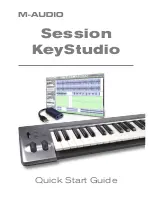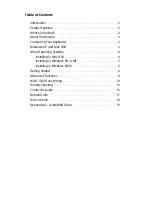
n
Chord names
Chord names will tell you everything you need to know about a chord. Through
the chord name, you know the root, whether it is a major, minor, or diminished
chord, whether a large or flatted seventh is needed and what changes or ten‐
sions are used - all at a glance.
n
Some chord types
8.15 Chord dictionary
The Chord dictionary is basically a built-in ‘Chord book’ assisting you to find the right
tones of a chord if you e.g. know only the chord name, but not how to play it.
1.
DICT 1 (chord learning mode)
Press the buttons
[SHIFT]
and
[DICT.]
simultaneously to call up the
‘DICT.1’
mode. In this mode, the keys from C4 on are used to assign the chord type, and
the keys from C6 to assign the root note. If you have pressed the keys for chord
type and root note, the display shows the chord name and the individual notes
in the notation system.
For example, If you want to play a Cm7 chord, press the C6 key (root note C in
the Cm7 chord). You will hear no sound, but the root note is displayed.
Press the A4 key (chord type for minor-seventh chord, ‘m7’). You will hear no
sound, but the chord name and the notes you should play for the specified
chord appear in the display.
2.
DICT 2 (chord testing mode)
Press the buttons
[SHIFT]
and
[DICT.]
simultaneously again to call up the
‘DICT.
2’
mode. The display shows a randomly generated chord name, but not its
individual notes in the notation system. If you play the right chord within three
seconds, the next randomly generated chord name appears. If this does not
happen, the individual notes of the chord in the notation system appear auto‐
matically in the display.
Operating
SP 5600
37
















































